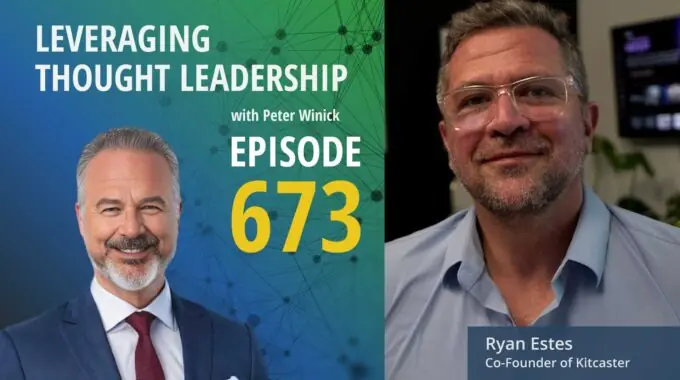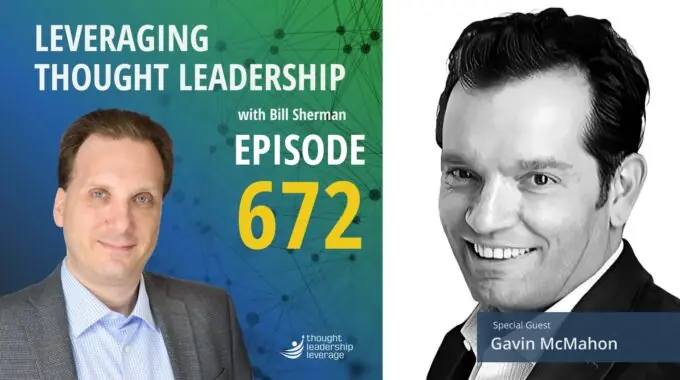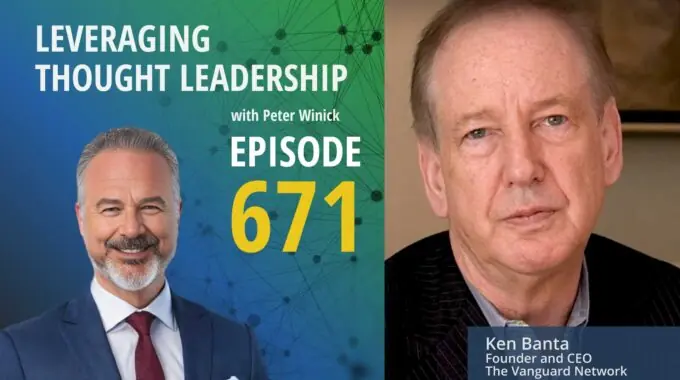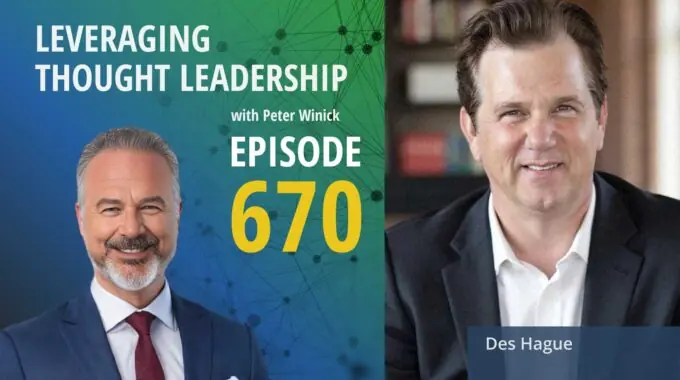Founder-led marketing, podcast strategy, and the art of authentic conversation What makes a podcast truly…
Unlocking the ROI for Non-Fiction Authors
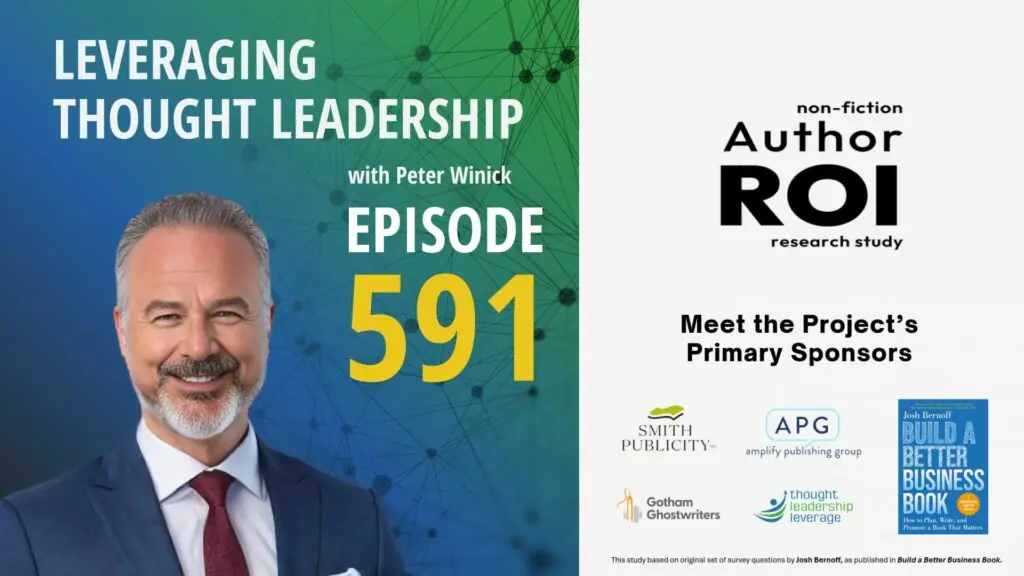
How does a non-fiction author create ROI?
Our panel of experts on publishing, writing, and marketing join us to discuss the findings of a survey that seeks to provide an answer to the question “How does a non-fiction author create ROI?”
In today’s episode of Leveraging Thought Leadership, our host Peter Winick is joined by Bill Sherman, co-host and COO of Leveraging Thought Leadership, Dr. AJ Marsden, an organizational psychologist and statistician, Josh Bernoff, author of Build a Better Business Book, Marissa Eigenbrood, President of Smith Publicity, Inc., Alison Schwartz, COO of Gotham Ghostwriters, and Naren Aryal of Amplify Publishing Group.
They discuss the findings of their recent research into the Return on Investment of publishing a business book.
In today’s presentation we will have a first look at the data that was gathered from hundreds of authors about their experiences getting published, the expenses incurred, and the results the book had on their business. These authors were reached through not only the friends and colleagues at Thought Leadership Leverage but those from many supporting sponsors such as Greenleaf Book Group, Marshall Goldsmith 100 Coaches, Page Two Books, and Zilker Media to name a few. Before the research could even begin, we had to ask the questions “What is ROI? How can you measure it? How much does an author spend? What is the effect of different publishing models? And what type of returns do authors see?
In answering these questions, we explore what the data tells us about the three different publishing models (Traditional, Hybrid, and Self Publishing), the role RP and Ghostwriters can play in the success of each.
We also investigate the hard and soft costs involved in writing a book and what the returns could look like. While many expect the sales of the book to account for much of their profit, we learn how using the book as a key part of a platform and gateway to other parts of the business is where real impact can be found.
More questions will be asked and answered in the white paper that will be released in September as we continue to pour over the data.
To watch the LinkedIn Live presentation: What’s the ROI for a Non-Fiction Author?
To receive a copy of the white paper when it’s release e-mail [email protected]
Transcript
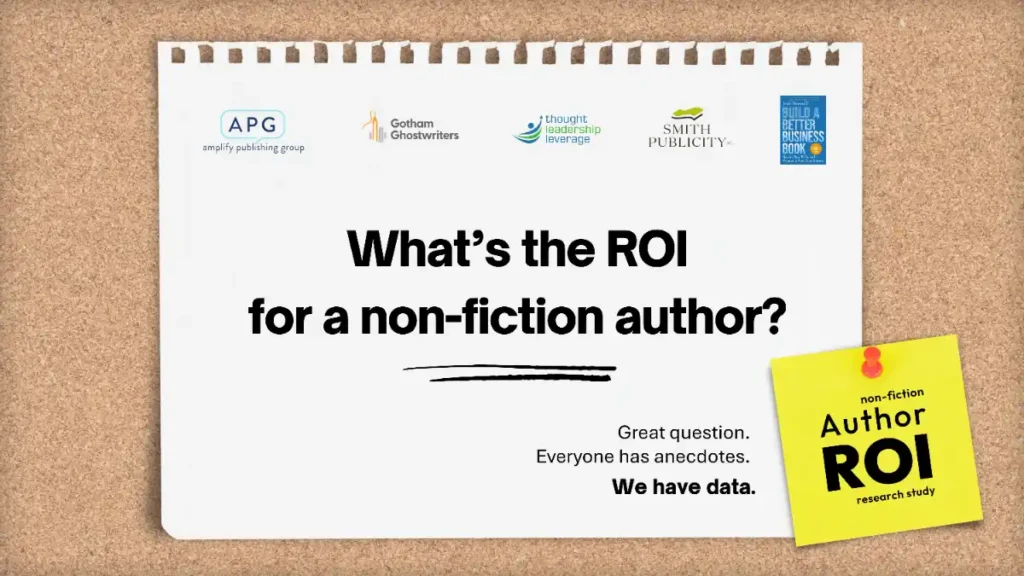
Peter Winick And welcome, welcome, welcome. This is Peter Winick. I’m the founder and CEO at Thought Leadership leverage. And this is sort of the special edition of the LinkedIn lives that we do. We are sharing with you all, some of the early findings of some research that we’ve just put together. So I want to just sort of thank all my colleagues here. So we’ve got Josh, we’ve got Bill, AJ, Alison, Naren, and we’re going to share with you some findings. We’ve put together some research and it’s really, really interesting. And it started over a conversation I had with my friend Dan from Gotham Ghostwriters, who we had a call one day and he said, you know, we hear a lot of conversation around what the ROI is for a nonfiction book. It’s something people ask all the time, where’s the data? And we realize there isn’t any. So we said, oh, okay, we could solve that. So let me just show you what we’ve got. If we go to the next slide, Bill.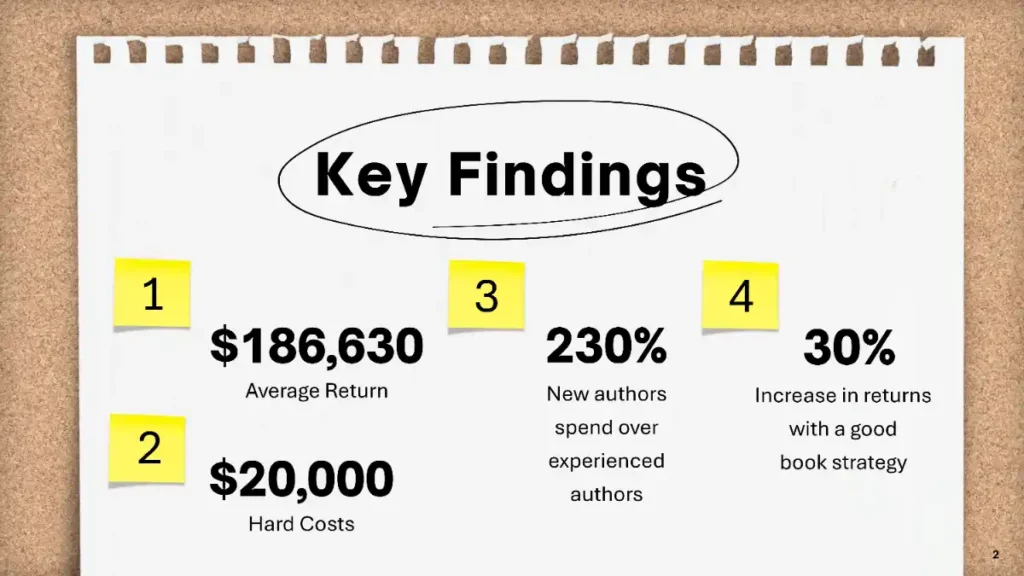
Peter Winick Okay. So, some of the key findings here are the average returns. So, here’s some good news for a nonfiction book is in excess of $186,000. That’s really good news. Hard cost 20,000. So, there’s some real cost here, and there’s some huge variance in the cost. We’ll get to that once we kick off the research team in a bit. New authors. This is sort of a cautionary tale for new authors. Tend to spend 230% more than experienced authors. Right. So, I think one of the takeaways for new author would be, well, how do I lower that number and get the return that someone that’s written at least one book has? And I’ll make those amateur mistakes, and then there’s a 30% increase in return. If you’ve got a good book strategy, which not, in my opinion, enough people do, but that investment into a strategy around your book, around your platform, around you, thought leadership, around your IP increases your returns 30%, which was a really significant finding. Let’s go to the next one, please.
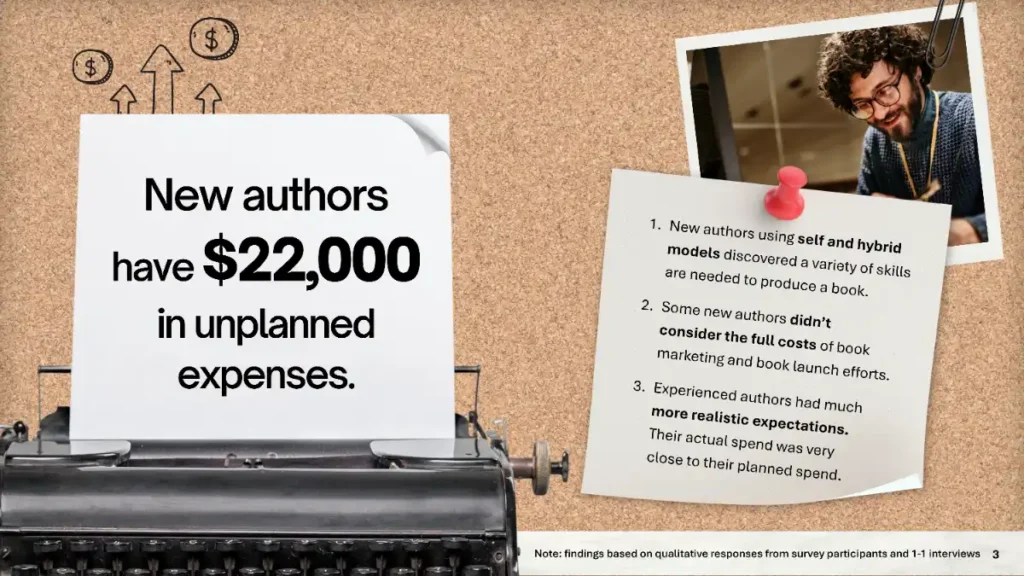
New authors. Again, this is a I guess when you do it, anything things happen $22,000 in unplanned expenses. So that’s scary. So again I would want to figure out well what might those look like. So I don’t fall into that trap. Let’s go to the next one here.
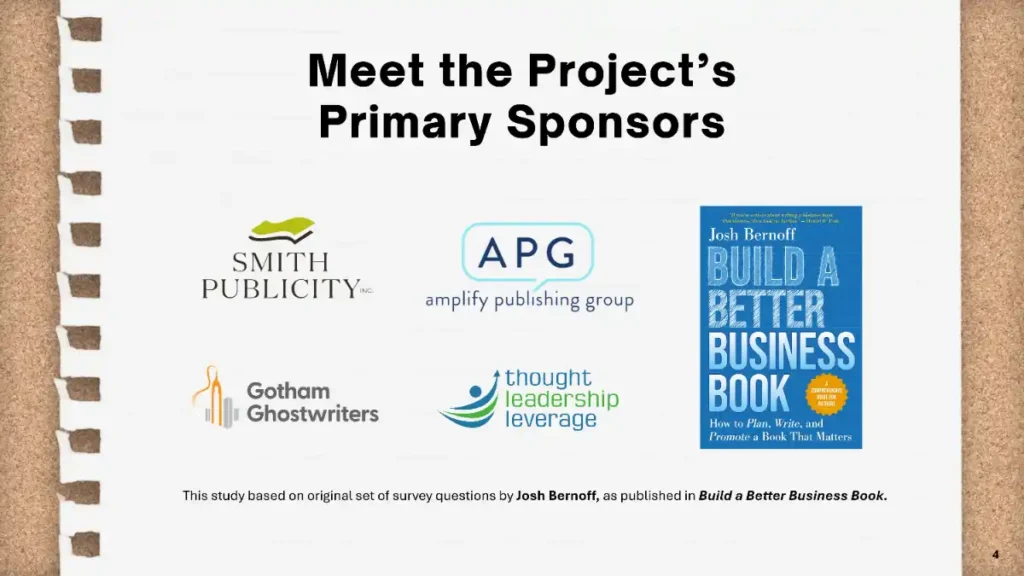
So our sponsors let me formally sort of tell you who the working group is. Here we have Smith PR who’s not on the call right now, but wonderful PR firm. Oh! There’s Smith. Oh, sorry, I didn’t see Marissa. I’m sorry, you popped in after and I can’t see. Marissa is over there from Smith. Great PR firm. We’ve partnered with them for many, many years. We’ve Gotham Ghostwriters. There’s Gotham. There’s Alison representing Gotham Ghostwriters. We have Amplify. There’s an Aaron from amplify. Wave your hand Aaron, in the orange shirt. And then we have Bill and I and AJ from Thought Leadership Leverage, and then the famed publish author, on the call, because we couldn’t do this without having a nonfiction book author is Josh Bernoff. And if you haven’t read Build a Better Business Book, I would suggest you do. In terms of in this space, I haven’t seen a better one out there. And, as Josh will tell you, I’m not someone that logs compliments frequently. It might be the first one ever. Let’s go to the next slide.
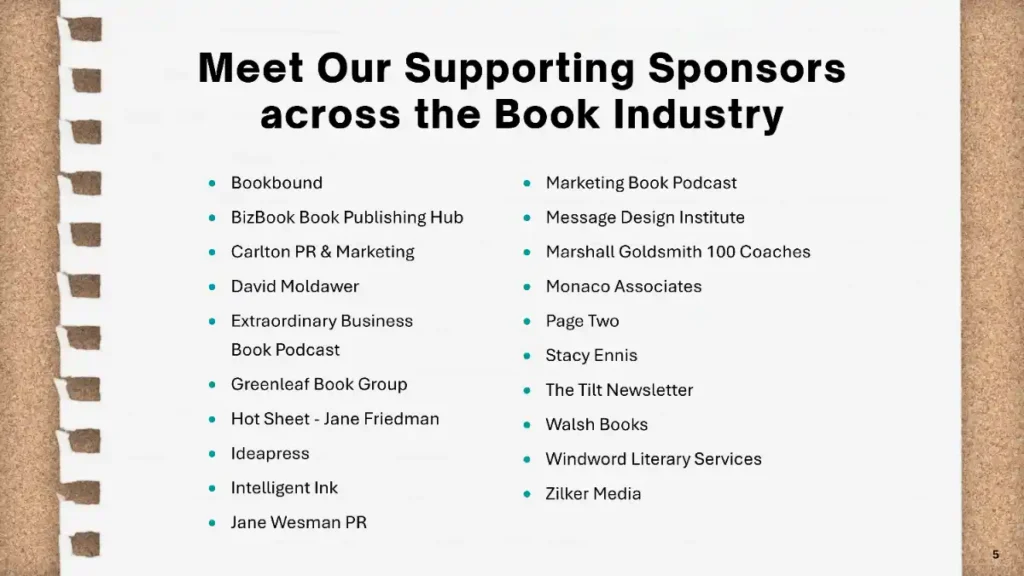
And we have a bunch of supporting sponsors. I’m not going to read them all. We couldn’t have done this without all these folks. We’ve had to ask a lot of favors, of a lot of friends and colleagues to say, hey, we need to get the critical mass here to get hundreds and hundreds and hundreds of people that have actually written books to give us their responses. So we didn’t care about the opinions of people that haven’t. You know, this is the sort of the Teddy Roosevelt man in the arena. We had to get to those folks and we couldn’t do it alone. So there’s lots of folks here that shared our information with their list. You know, I see Page Two, I see, Green Leaf book. I see some others. My eyes aren’t that good. Intelligent Ink. And there’s lots that have helped us. There they are. We thank you and appreciate your time. And let’s go to the next one.
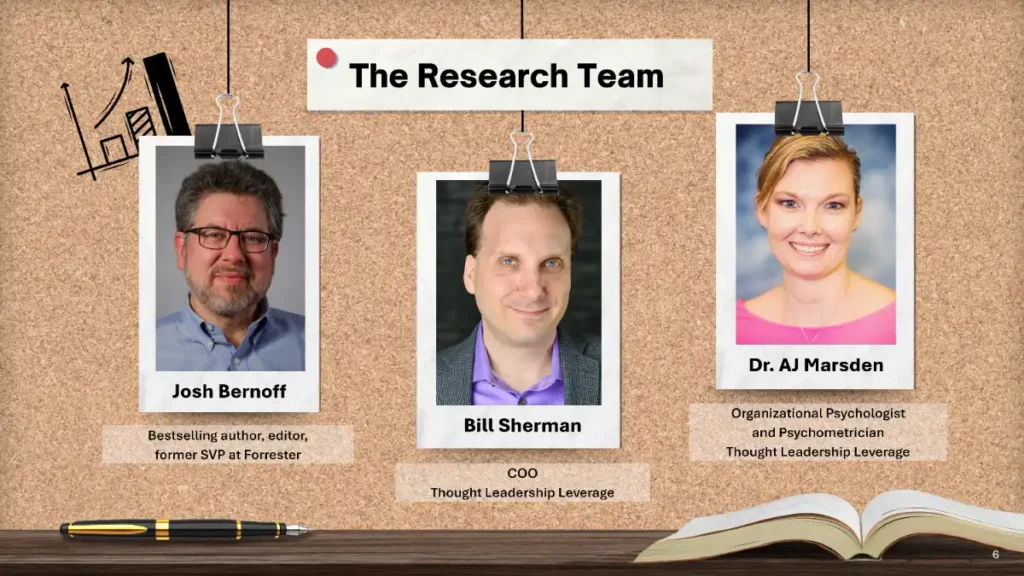
And our esteemed research team. And this is where I’m going to hand it off to Bill is Josh theory. There’s Josh again. That might be Josh’s younger brother in that picture. We’re not sure that later because Bill and Dr. AJ Martin from my team. So Bill, let me hand it off to you. And then Jess, if we can blow up the slide to full screen once we go to Bill, I guess Bill off to you.
Bill Sherman Hello and welcome everyone. So yes, when this question came to us, we said we had two challenges. One, how do we get data from as many authors as we can? And Peter just alluded to, we not only asked our friends and colleagues, we asked authors we knew, but we also had to answer a question what is ROI?
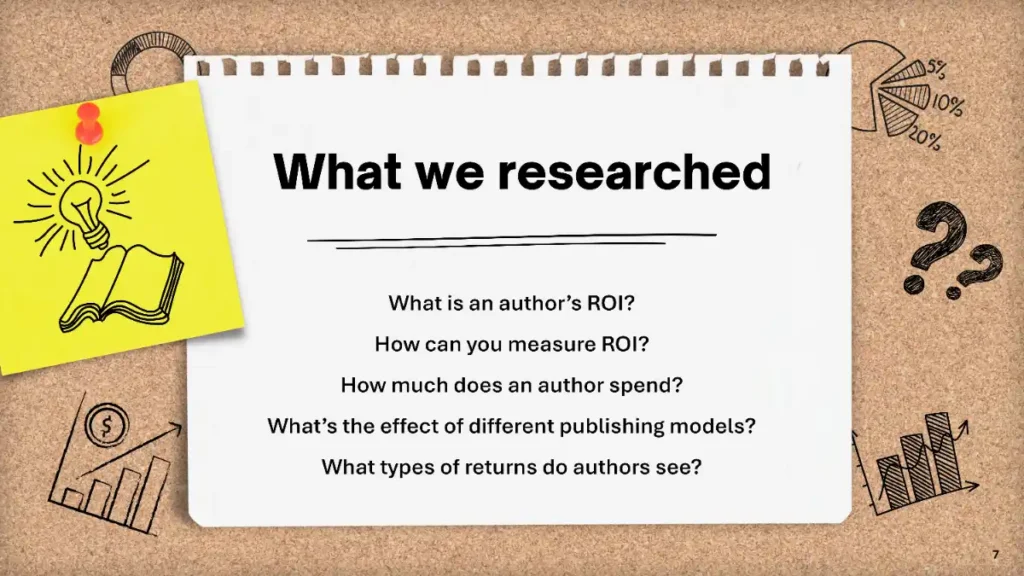
So, in today’s conversation, we’re going to talk about what is an author’s ROI. How can you measure it? How much does an author spend? What’s the effect of different publishing models and what types of returns do authors see? So, we put this research study in the fields. Well, we actually started back in April and we fielded it over June through the July 4th holiday. We’ve done the analysis. What we’re sharing today is some of the first cut and high level teasers of insights that we’ve found. And by we I want to give a nod of acknowledgment to AJ Marsden, who as an organizational psychologist and statistician, did a deep dive into the data and really helped guide not only from the hypothesis side, but also then the statistical analysis of what’s going on. So you’ll see some footnotes in this presentation every now and then that look like statistics. They are. We’ll explain them more in the white paper that comes out later. But realize that what we’re saying today is data based and evidence based. So let’s start with the first question.
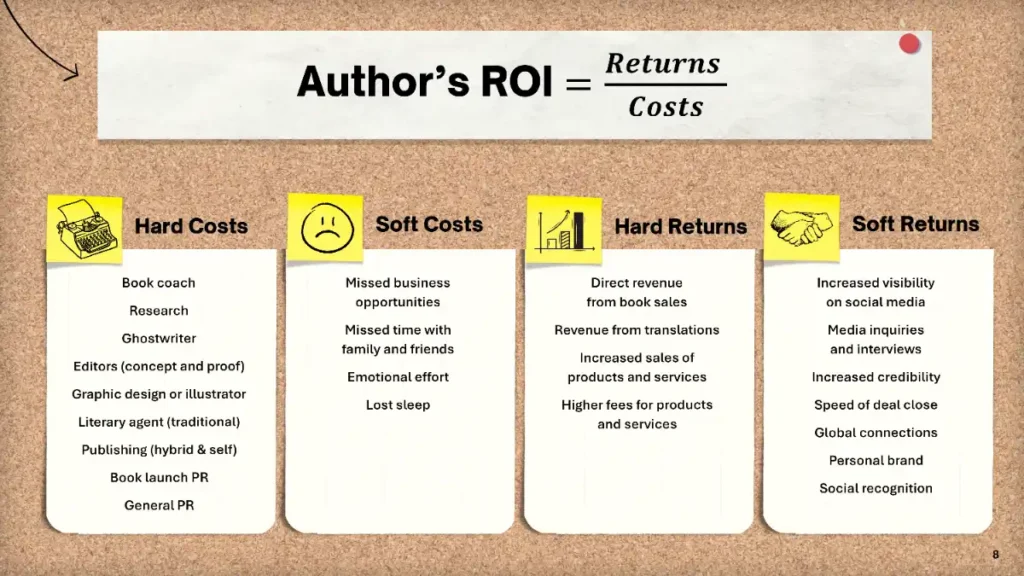
What is an author’s ROI? Well, really simply returns versus costs. Well how do you break that down? So Josh, AJ and I started with this question and we wound up building a pretty long list of costs, of which you’ll see some in the first column here. Coaches, editors, literary agents, publishers, book launch PR, ongoing PR, all sorts of ways that you can get help in the process of writing and promoting a book. But there’s also shop costs too. It takes time. Evenings. Weekends. You might miss business opportunities because you’re business writing. There’s also the lost time with family and friends. There’s emotional effort and even, quite honestly, lost sleep, right? So if that’s some of the factors on the cost side, where do returns come from? There’s direct revenue from book sales. There’s revenue from translations, increased product and service sales, higher fees for products and services. And that turns into all those are hot. Although those are high level categories. That turns into a lot of subcategories. And so for those of you who went through the survey, I want to give a big shout out and thank you. Because yes, it was a 30 minute survey and it asked a lot of detailed questions, but we realized if we were going to get to an ROI calculation, we needed to ask about numbers. So the final category are the soft returns. You get more visibility on social media. Maybe it’s media inquiries and interviews. Increased credibility. That’s a big one. Speed of deal close greater connections nationally, regionally, globally, a stronger personal brand and social recognition. All of these things factor into an ROI. Some of them can be quantified directly and financially. Some of them can be quantified, but not financially. And some of them quite honestly, at the level that we’re talking about, are impression based. So it’s hard to answer with a purely dollar level number. So you’ll see sometimes we divide things out as we go forward.
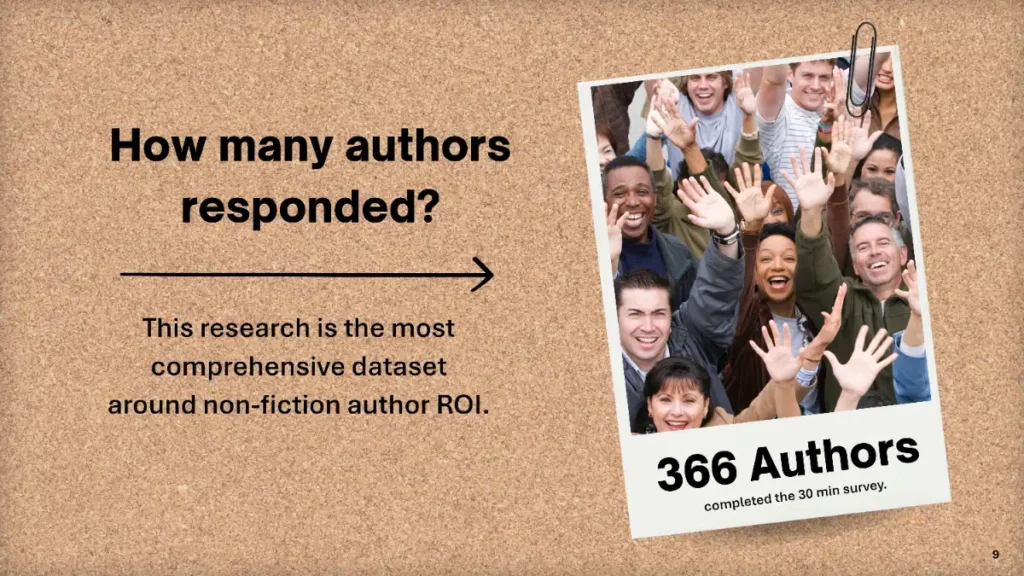
So I want to hand off to Josh here to take us through some of the info about the authors who responded. And Josh, having done a survey for Build a Better Business Book that served a foundation, sort of guided us on this. Josh, over to you.
Josh Bernoff Thanks very much, Bill, and I just want to thank the sponsors for allowing me to participate in this. What we decided to do here was to try and go beyond that original survey in two ways. One, we wanted to get enough or enough authors that we could actually do some statistical analysis about which factors led to increased ROI. And as you’ll hear later in, in the presentation, we were able to successfully do that. And we also wanted to make sure that we were able to ask specific financial questions that could lead into that model. We were pretty successful by reaching out to all of those partner organizations. We managed to reach 366 authors, of which the great majority of already been published. And, I’ll be talking a little bit more about the breakdown of who we reached, and then we’ll get into what we found from them. Next slide please.
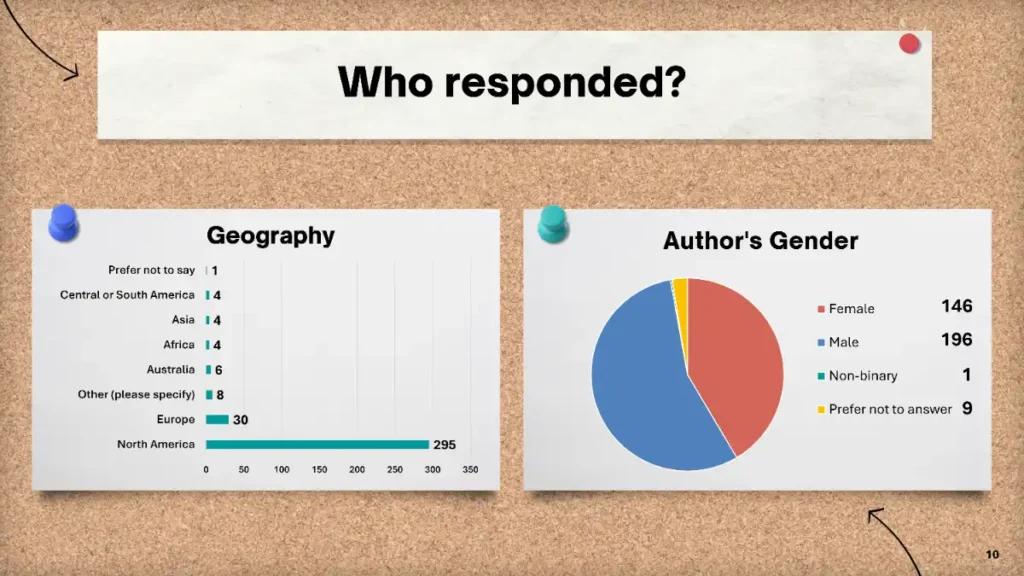
So who did we find? The overwhelming majority were people from North America just related to who we reached out to. But we also had 30 European authors, as well as authors from, Central and South America, Asia, Africa and Australia. Our breakdown by gender was, a little bit more male and female. And based on our experience, and if you talk to any publisher, this is fairly typical for business folks these days. It’s not quite a 50/50 split. And there there’s certainly almost half of them, that are female. Next slide please.
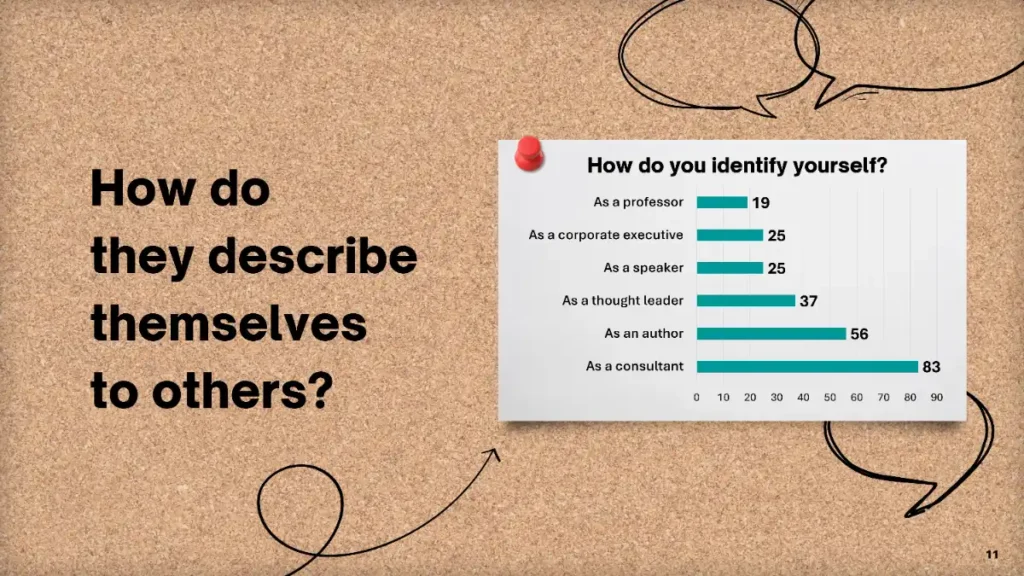
It’s interesting when we talk to people as opposed to, say, fictional authors, nonfiction authors identify themselves using various terms and more of them, 83 of the ones who were published, identify themselves as consultants. Only 56 were primarily said that they identify themselves as authors and other things – thought leaders, public speakers and corporate executives and professors made up the rest of that. Next slide please.
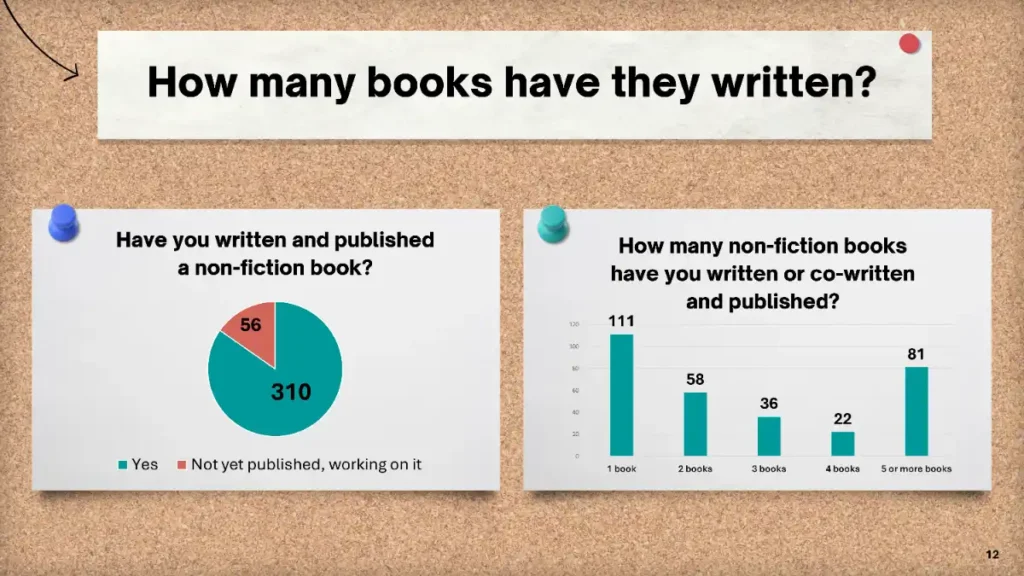
So a little bit more about who we reached. Of the 366 people that we reached so far, and we are still collecting data, so when the white papers published, they’ll be even more than this. But of the people we reached, so far, 310 had actually published a book and 56 had not yet published. And we’re working on it. And when you see the final analysis, almost everything that you see today is going to be from those published authors. In the final analysis, we’ll be talking a little bit more about the differences between people who haven’t yet had that experiences and the ones who did. It was fascinating to me to find out that a lot of these folks had gone on to publish more than one book. 111 out of the 310 had published one book. We had 81 authors who had published five books. And this allows us to draw some conclusions about the actual tactics, spending, and returns from experienced authors versus first time authors. Next slide please.
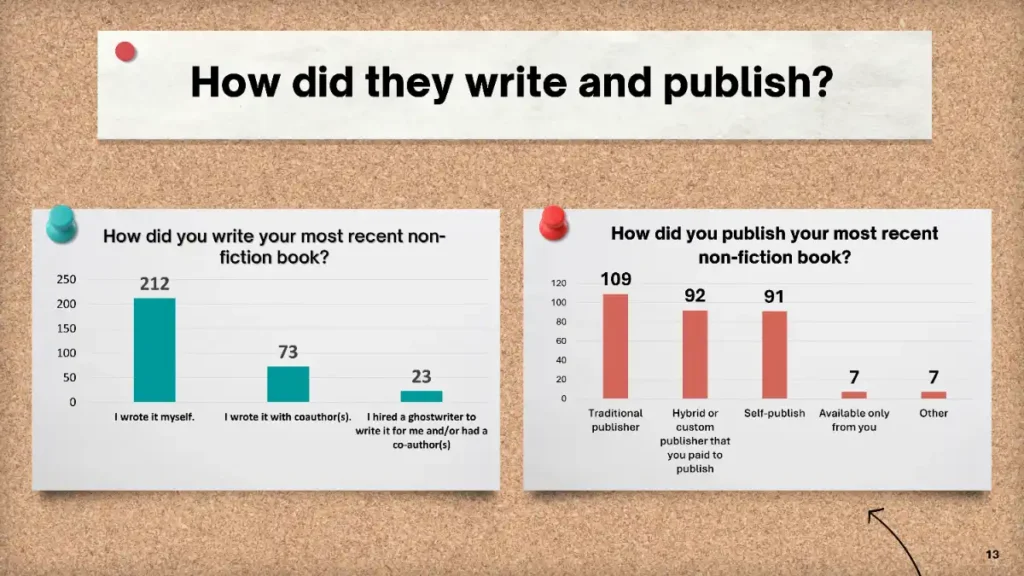
The other thing that’s important in understanding these folks. The main break down is how they wrote the book 212. The vast majority of them, wrote it themselves. But we had 73 people who wrote with coauthors and 23 people who wrote with ghostwriters. And we’ll be talking a little bit about how those people, who worked with ghostwriters, often have some of the best returns. Also, whenever you see a survey of this kind, it’s important to recognize that there’s three very different groups. The people who work with traditional publishers, folks like Wiley or, Harper Collins, for example. There are the folks who work with hybrid publishers like our sponsor from Amplify, and then they’re the folks who do self-publishing and take care of most of it themselves. And business authors are able to be successful in all three of those modalities. But there’s a very different amount of cost that’s different types of costs that come based on those three, ways of publishing. And we’ll be getting into more detail on that in a moment. All right.
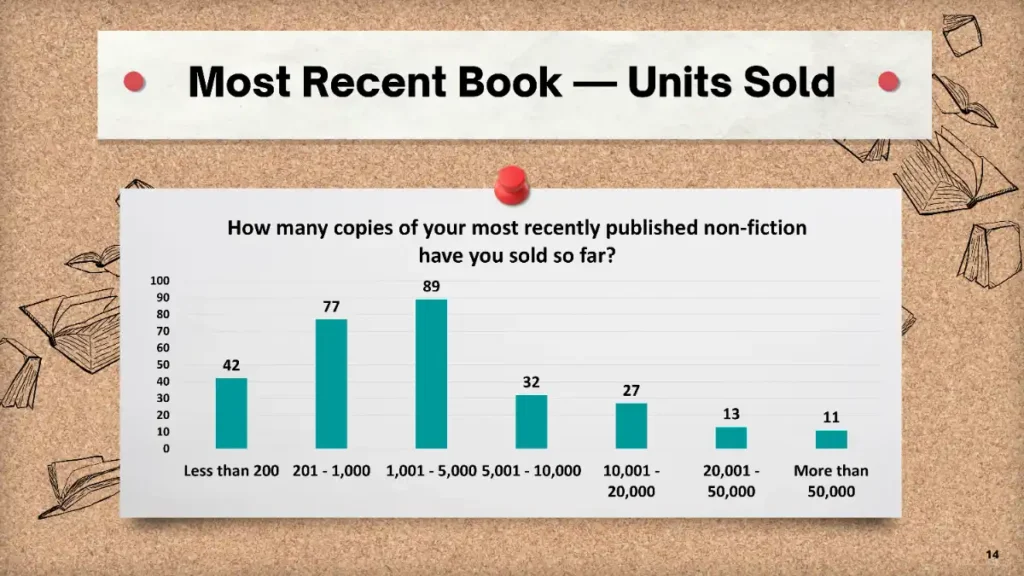
Last thing that I’m going to talk about is this question of sales. How many copies of your most recent book sold so far? And for a more detailed analysis, we need to account for people who published very recently and maybe have had fewer sales. But I think if there’s one generalization I’ve learned from talking to authors over the years, it’s their expectations of sales often are in excess of what they actually sell. As you can see, the most common sales figure is 1000 to 5000 books, and only 11 of the authors that we talked to sold more than 50,000 copies. However, people who don’t sell a lot don’t necessarily have a lack of success. In fact, if you only sell a thousand books and then 10% of those people sign up for $100,000 consulting contracts, you’re doing pretty well. All right. I’m going to turn things over to Bill to talk about some insights on what actually drives the ROI.
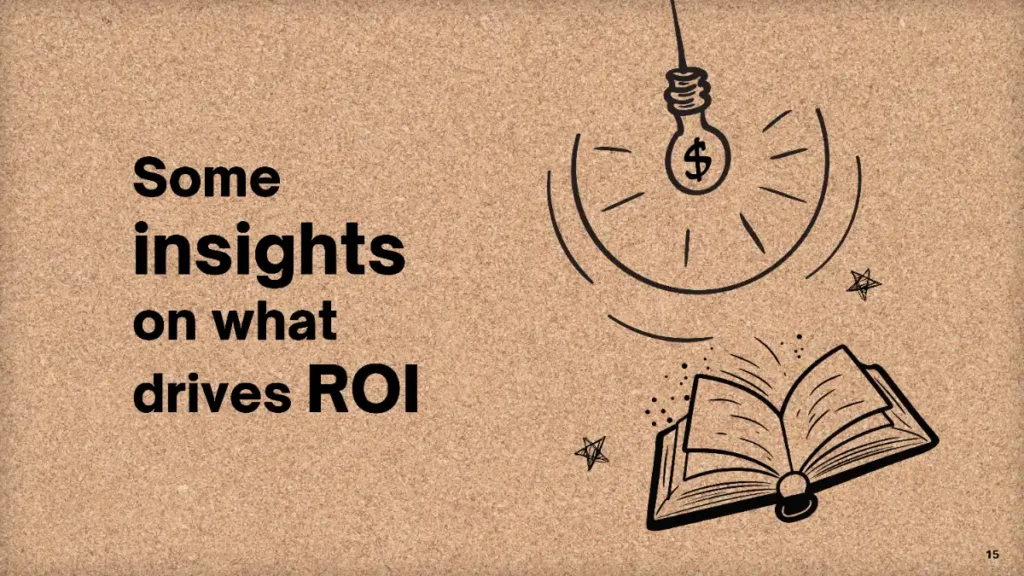
Bill Sherman So we’re going to start diving into some of the relationships between hard and soft costs with ROI, as well as then hard and soft returns on ROI. This is not a comprehensive look. As we said, this is a first look and I will be tagging in some experts in different areas as we go along to speak to certain points on this, but we really sort of want to paint a picture. And we found some interesting things as we started going through the data, some findings that confirmed what intuitively seemed right. And then also some things were like, wow, that’s interesting, tell me more. So you will see us mentioned things here, which will be explained further in the white paper which will come out in September.
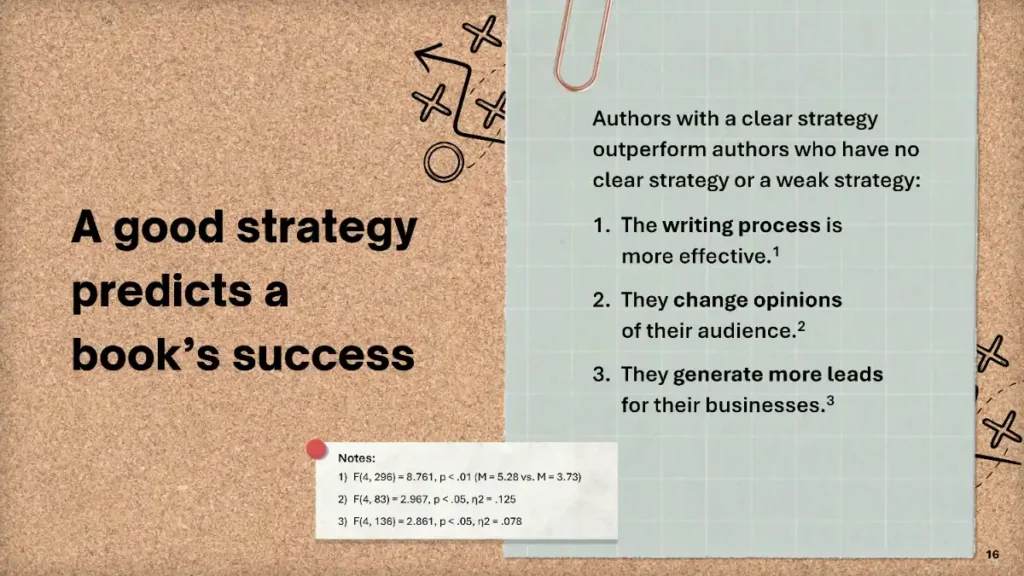
So, the first thing that I want to talk about here is a good strategy predicts a book success. And to some level that makes a lot of intuitive sense. If you go in knowing what you’re going to do with the book, you’re more likely to succeed at that. But the key word here is predicts. And I’ll come back to that in a moment. But there is a strong relationship between authors who have a clear strategy and their writing process. They told us their writing process was much more effective if they had a clear goal and strategy. They also reported that they’re more successful changing their target audiences’ opinions. Their primary audience they said, “I’m making an impact more effectively because I had clear goals and because I had a strategy.” And then the third piece is they generate more leads for their businesses. So for the authors who are using the book, not just to change how people think, but also support their business or a business they work for, they saw a significant difference. Now I want to put a small asterisk here, and I want to turn to AJ Marsden. And AJ as we go into this data, I’d like you to answer a couple basic stats questions, because we’re going to be tossing some terms around and give short 30 second answers if you could to these. Number one, what’s the difference between correlates and predicts?
AJ Marsden That’s a really good question. This is something that people often get confused. There’s a difference between correlation and causation, right? A correlation is when two things are related to one another. So, IQ and shoe size there would be no correlation there. We would not expect those two things to be related at all. When things are positively correlated, that means they both increase, or they both decrease at the same time. And if there’s an inverse or a negative correlation, that means as one variable increases, the other one decreases. So that’s correlation. They’re related, but one does not cause the other. Causation or prediction is where one variable causes another variable to happen. In this case we were able to look at that by looking at the differences in the type of strategy that authors use. So we were able to see that having a good strategy actually does predict the book’s success.
Bill Sherman Thank you. Now I want to ask one other question, because this is going to come up as we go through the following slides. And it’s the difference between median and mean. Let’s say I have a list of seven responses to a survey question. How do I find the median and the mean and why are they different?
Dr. AJ Marsden That’s a great question. So the median also called the average. This is where we add up everything. And then we divide by the number of people that are in our groups. Right. So this is just the basic average in mean is just taking everything adding it up, dividing by your total number of participants.
Bill Sherman So if I have seven participants I divide by seven.
Dr. AJ Marsden Exactly. Yep. Okay. A median is a little bit different. So this is where we’re finding that exact middle point right. So I would line up my numbers my seven numbers from 1 to 7. And I would find the one that was right in the middle. The median is better in some ways and should be used if you have data that has potential outliers. An outlier is a variable point that is really, really far away from the rest of your data. So in our case, we had a lot of offers. Who said that they bring in, you know, $50,000. But there’s this one author who said they brought in $5 million. Now, how we calculate the mean and how we calculate the median is very different. That outlier is going to influence our mean or average and pull our average closer to that outlier. But the median doesn’t do that because the median doesn’t take that into account. It only looks at the range of the numbers and what number is right in the middle. So in these cases where you have these potential outliers that could pull your average, it really is better to use the median to report your numbers.
Bill Sherman Thank you. And you’ll see in this report that our findings we talk sometimes about average and sometimes about median. And the reason we’re calling them out and you’ll see is there’s a difference between these numbers. And that’s going to be something that will be called out in the white paper. One of the early pieces that we can point to is people who have a good strategy, who are successful, wind up being more successful. In short, winners tend to win more because they execute on a good strategy.
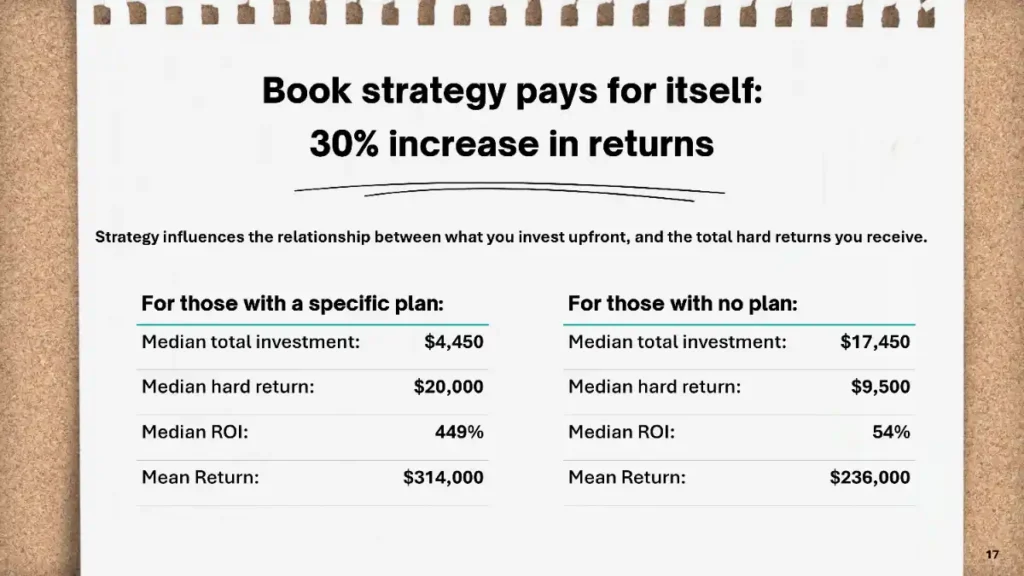
So let’s move forward and continue down that strategy. And this goes to the difference between median and mean return. And here we’re talking about the returns. As you can see on the left those who have a specific plan see a median return that’s much higher than those who did not. In fact those who didn’t have a plan didn’t do very well at all. The mean return is higher and significantly higher, right? Because there were some people, like I said, who were very successful. And so what you need to think about is in the category for the people with no plan. As an author, it’s entirely possible that someone I live in Las Vegas, they go down to the casino, they put money on double zero on the roulette wheel, and it comes up and they win. Big, right? Someone’s going to win the jackpot. If you have a large enough sample, but on the whole, strategy produces at least a 30% increase in returns because you know what you’re doing. You know where to spend time, energy, effort, and investment. And then that leads to a question.
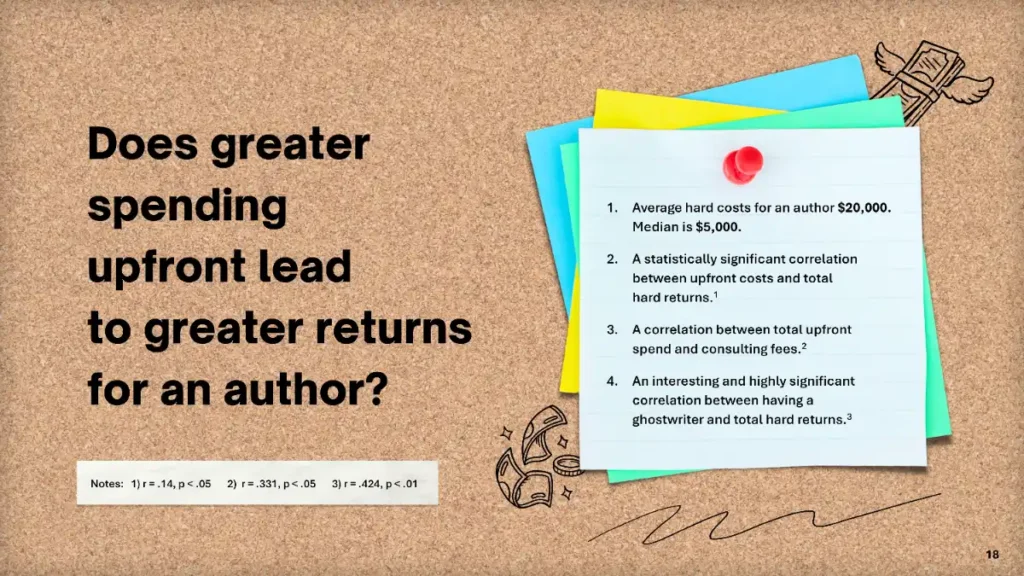
Well, if I spend more, does it lead to greater returns? Okay. Again, the difference between average and median here. There’s a difference in average costs between 20,000 and 5000. And we saw a statistically significant correlation. In other words, as AJ said the numbers move together. They both go up. As you spend more you get greater returns. Okay. And that upfront correlation also aligned with consulting fees. So, if you’re looking to do consulting and you spend more on the creation and publication and promotion of the book, you saw a higher return on the consulting side. We also saw something very interesting, which was a significant correlation and a strong, significant correlation between did the author have a ghost writer and their total hard returns. And this did not depend on where they traditionally publish hybrid or self-published. And we’ll get into that a little bit more. It bore pointing out to, that the dollars and purposeful spend that you spend create your book, really does have an impact on the results you see.
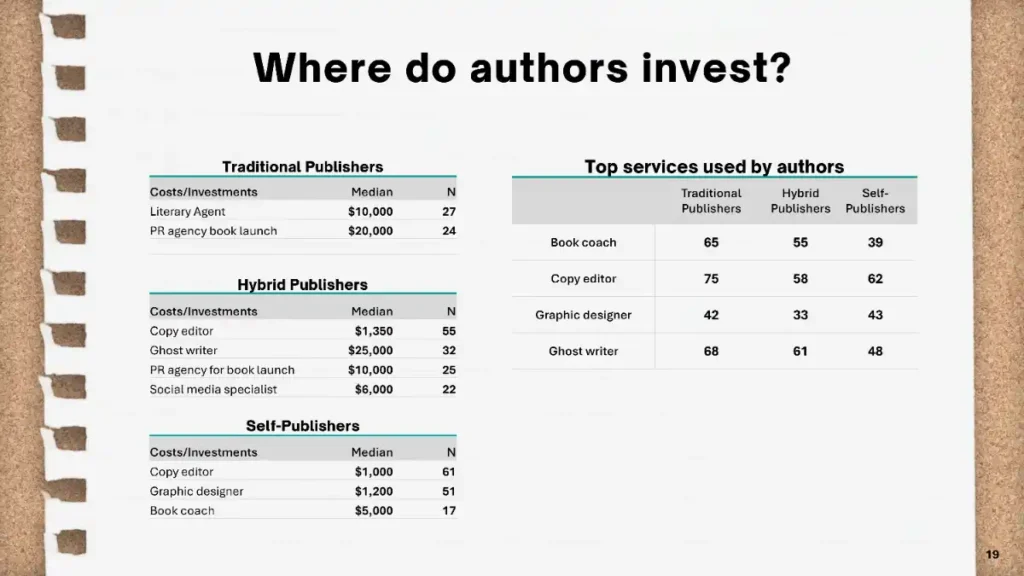
So, Naren, I want to hand off to you for a moment. And can you walk us through the difference between traditional, hybrid and self-publishers and maybe speak to some of the insights you see here on the screen?
Naren Aryal Yeah, absolutely. Thank you all. Great to be here. So, first of all, traditional publishing includes the big five. Its features are you need to find a literary agent to represent you in your project. You create a book proposal you sell to the house. There’s typically some level of advance, so there’s no author funding, and there’s a royalty rate of typically, you know, call it between 10 and 15% royalties to the author that are applied against the advance, whatever that advance may be. Then there’s self-publishing. You are the general contractor for your book. You hire an editor a designer, marketing folks, anybody that’s required to create and launch your book. And most folks use services that Amazon or Ingram offer. And lastly, where we reside is the hybrid publishing space. This is the area between traditional and self-publishing. It is an author funded model. The royalties are typically higher to the author. Author retains a lot of control in the process in addition to owning the intellectual property. And interestingly enough, the IBPA has a list of criteria, that they have published. That speaks to exactly what makes a hybrid. And if for any of those that are interested, I’d encourage you to go check out IBPA and, examine those nine niner. I think it might be expanded to 11 criteria. So, those are the three main areas. And, in terms of the cost here. I will say just being in the hybrid space, there is a wide range. And I think this is, something to point out. I’ve seen projects that cost less than what we have here in the hybrid space, and I’ve seen projects that cost, frankly, a lot more. And you mentioned ghostwriting. That’s typically a big line item that needs to be accounted for if, in fact, you’re working with, a professional writer like our colleague Josh Bernoff here. So hopefully that gives you a good background. And I’m happy to when we get to the Q&A session, answer some questions.
Bill Sherman And then, Alison, if I might. One of the things that I want to call out here is on the right-hand table of services used. One of the things that we see is a fairly equal distribution of top services, including ghostwriter. If you could speak to how you have seen ghostwriting, integrate with all three of the publishing models.
Alison Schwartz Sure. And it’s great to be here with this group of people today. Thank you. At Gotham Ghostwriters. We see two primary buckets for ghostwriting services. Clients that are pursuing traditional publishing and getting working with the ghost, put together a book proposal, and clients that are going straight to the full manuscript and working with a hybrid publisher. We do see a few self-published books, but our primary two buckets of projects we see are hybrid and traditional publishing. Regardless of which direction you take, the most important thing is to find a ghost that is proven, has the right subject matter expertise, and has the chemistry and the fit. We tell everyone to make sure you write a proper process and take your time and find the right ghost. That is crucial.
Bill Sherman Thank you, Alison. And then Marissa, if you want to speak to the work, PR agencies within the three frameworks.
Marissa Eigenbrood Absolutely. So here at Smith Publicity, we work with authors from all publishing paths. And I will say that what I think is the overarching kind of theme and what we see in our work is that the book launch is important, and you want to place your excitement and your emphasis on that build up and ensuring that moment is really celebrated. However, you shouldn’t be the end all be all, because when we talk about what we’re seeing the true ROI come from here, that return. It is in our consulting fees, it is in our speaking fees, it is in these other offerings that we have, and so ensuring that whatever plan we’re building out always feeds into both other elements of your overall brand ecosystem from marketing publicity perspective. We want to think about the short game, but also the long game so we have a head to. And those things are really important for us to keep in mind, no matter what publishing path you selected.
Bill Sherman Fantastic. Thank you.
Peter Winick And if you’re enjoying this episode of Leveraging Thought Leadership, please make sure to subscribe. If you’d like to help spread the word about our podcast, please leave a five-star review at rate this podcast.com/ltl and share it with your friends. We’re available on Apple Podcast and on all major listening apps as well as at thoughtleadershipleverage.com/podcast.
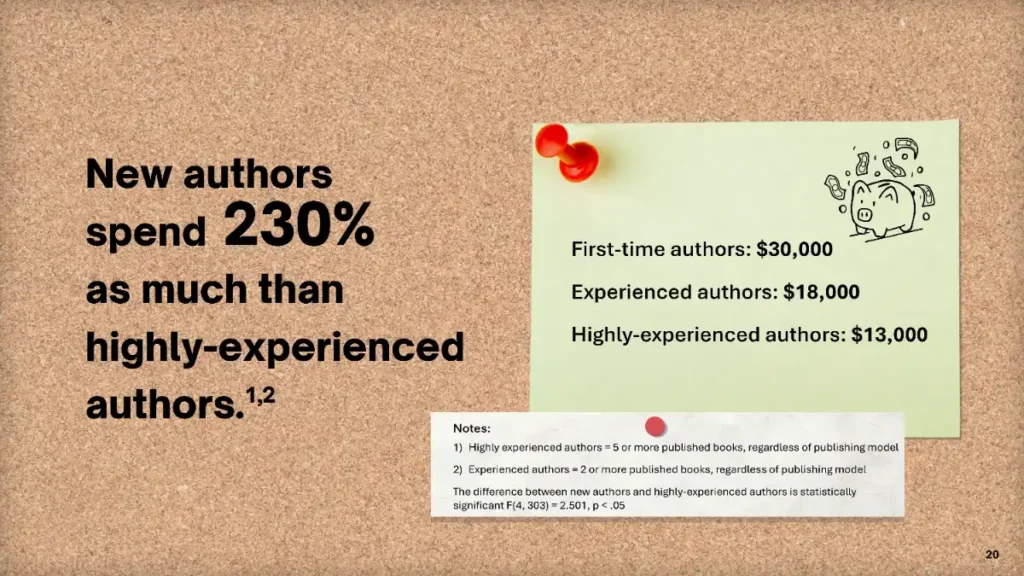
Bill Sherman So I want to dig a little bit deeper in terms on hard costs, new authors. You heard Peter say wind up spending $22,000 more than they expected. They’ve got $22,000 in unexpected costs as first-time authors, but they also wind up spending 230% as much as highly experienced startups. So if we look over on the right and the green, let me give a few definitions here. First time author. Self-explanatory. We defined experience author as someone who had published two or more books. In other words, this wasn’t their first rodeo. And we asked them specifically, what did they spend on their most recent book? Okay, so we had clear data between first time author spend and second plus author spend. And then we also broke out a category for highly experienced authors. And here the spend was much more targeted. And as we said, there is a statistically significant difference between first time out and highly experienced. They are purposeful. They have a clear strategy, and they know the help where they want help. Now again, we’re talking about medians. We’re talking about a wide range low and high. Do not take this slide as I should only be spending X on my next book. Because remember the previous conversation that I had where I said there is a correlation between the more you spend and the more returns you see? Okay, that’s important to hold in mind when you look at these numbers.
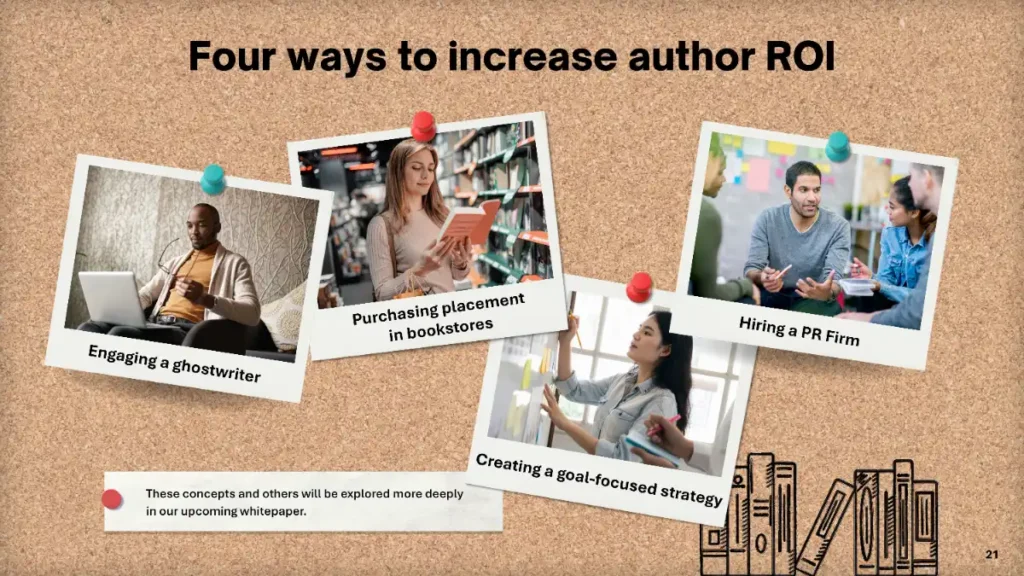
So a little bit of a teaser on the hard costs and hard returns. We saw correlations in a few places. They’re worth calling out. We have a limited amount of time together today, but as I mentioned, a strong correlation between engaging a ghostwriter and hard financial return on the book. The second place that we had an interesting hypothesis, and this is one that we went into the survey, Josh, AJ and I asking ourselves, okay, in-store book placements are an expensive, often way to promote the book. Do authors report they pay off? And the answer was yes. We’ll have more information on that in the white paper. You heard me talk about creating a goal focused strategy and the increase in ROI of 30% as a result. The third area, hiring a PR firm and having that specific marketing strategy and campaign for the book, and looking at the book as something that can create impact not just within a season of book launch, but something that extends as almost an asset for 5 to 7 years, really allows you to continue to get the word out. And so these four you will see more of in the white paper.
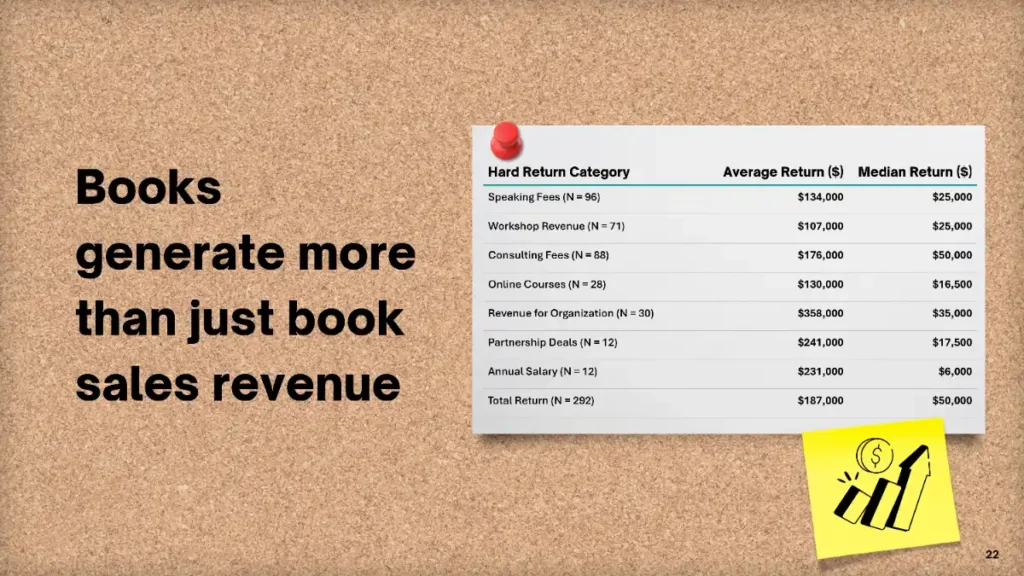
And here, I mentioned revenue outside of book sales. Here’s some details. And again, we’re sharing the averages and the medians, speaking fees workshop revenue consulting fees, selling online digital courses. Some people reported, hey, I work as an employee for the organization. I wrote the book on the organization’s behalf. Here’s a quick estimate of what we think the book has done in impact. There was a wide spread on that because some people had written books for firms that were doing tens or hundreds of millions of dollars. Okay. What impact did they see on partnerships, their personal annual salary and the total return? So if you think of the book, and I think intuitively, most people know they’re not going to get rich simply by publishing the book unless it becomes a runaway bestseller. If you’re looking for financial returns, you have to think expansively and creatively and strategic around how you’re going to generate that revenue.
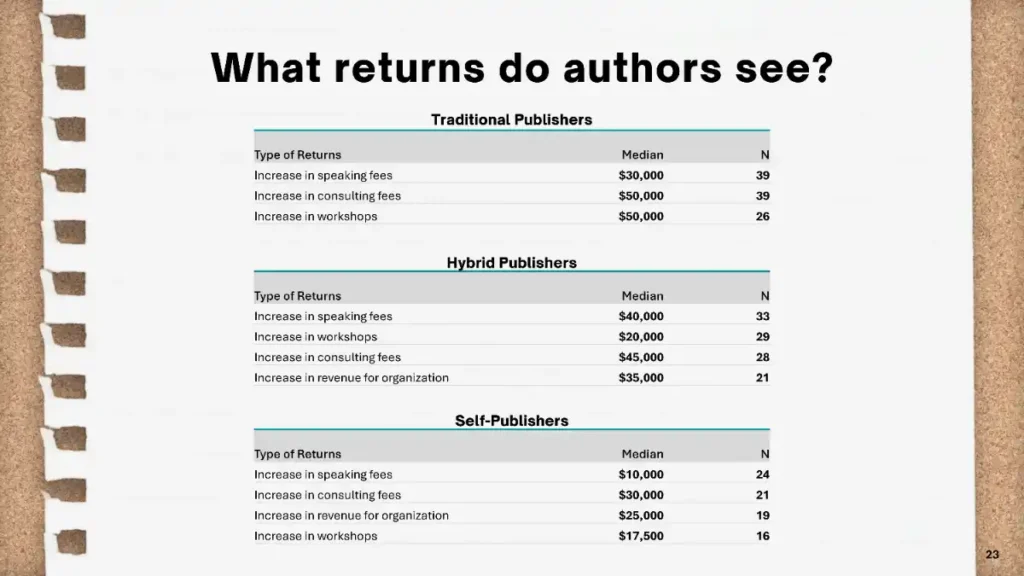
So what returns do you authors see? Naren, I’d like to return to you to talk about these.
Naren Aryal Sure. So I think one of the key things that you just said was, more than just book revenue. And so, what we see time and time again is those people that view a book as a key part of their platform and see it as a gateway to these other areas, be it consulting or a keynote speaking. That is where the revenue in the long-term impact, is typically achieved. And so this here, you know, in the world of hybrid publishing, we work at amplify. We work with a lot of keynote speakers. And so they always talk about increased speaking fees, and you see that there more stages at increased fees. You’ll see that there. And they’re also, you know generating revenue through workshops and consulting, which we talked about. So that is, the way to think about the why of a book project.
Bill Sherman Fantastic. So…This also leads to the question of soft returns.
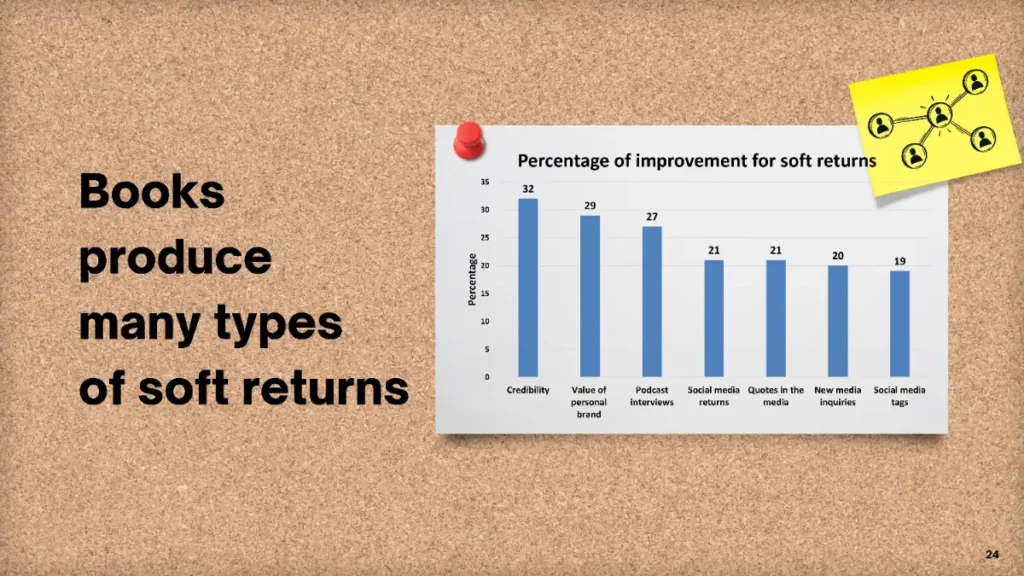
And Naren, you’ve worked with a number of authors as well. Can you speak to this?
Naren Aryal Sure. And so when we’re talking about hard returns, everyone wants to sell as many books as possible. Right. And so that is the direct ROI. The soft ROI is, you know, increasing visibility, increasing media, increasing all the business opportunities that you’ll see right there on this chart. So again, we’re sort of, you know, coming back to the same point, the book as a money maker is somewhat speculative on its own. But when you add all of these lines of business, what we’ve seen and what the data shows in the survey shows is that’s where the return lies.
Bill Sherman Thank you. So I want to take a step back here.
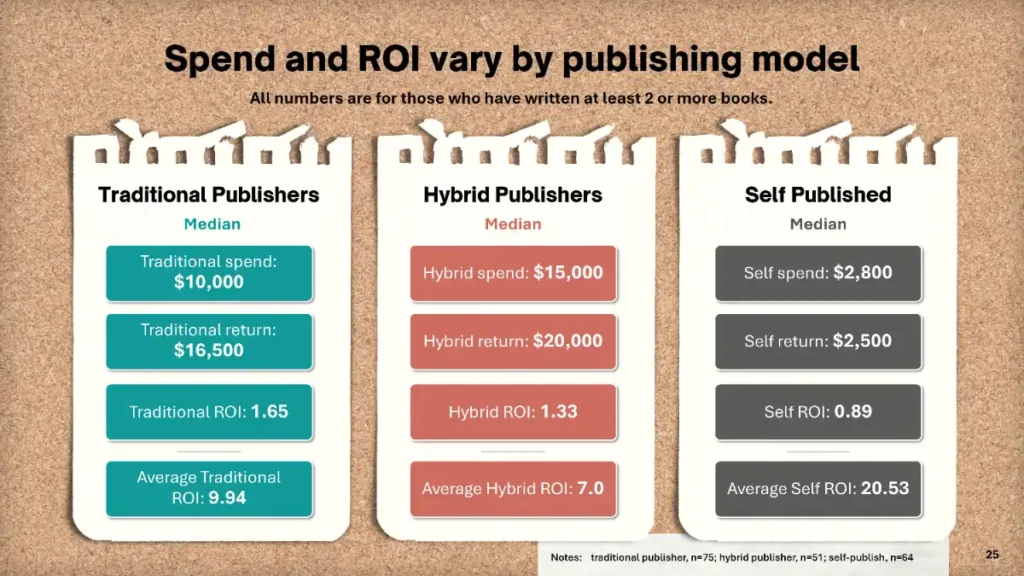
We ask the question, what is ROI? And we answered that with a framework a hard and soft cost, as well as hard and soft returns. We calculated some hard return ROI. And we broke it out by publishers. And we also broke it out by looking at people who have written at least two or more books. Because remember, we saw a significant difference between first time authors and second time authors. And so, if you look at these categories, what we’re sharing here on the first three boxes on spend, return and ROI are medians. And as AJ said earlier, to calculate that median you line up low to high and then you find the midpoint of all of the numbers reported. And so for each we saw a median ROI that was positive and significant. Now because there is a wide range, we’re also including the averages here. And remember that I said winners who have a clear strategy tend to win more. I call your attention to and compare the difference between, regardless of which publishing model you’re looking at, the ROI median, which is in the third box in each column, and the average for each ROI in the fourth box. So traditional ROI for traditional publishers 1.65. The average 9.94 winners win more hybrid 1.33 to 7.0, and then self-published the median. Lot of people said, hey, that’s a published book. Didn’t make its money back. It was lower than the spend on hard spend. Now they have created value to the brand. Credibility helped them close deals. But from a hard financial return perspective, self-published authors who had published at least two or more books didn’t see the return in Hard Return. But as a medium. But if you look at it as an average, there were certain authors who had a fantastic. Return on their book. In fact, in qualitative interviews that we did to accompany this, I had a conversation with the gentleman who had written a self-published book, and he said, before we start, I know you’re not going to believe my numbers. I tapped into a niche. It became a runaway, self-published success that I wound up paying off my house and putting significant money in the bank as a result. And he said, this has been almost an annuity for me. It sells year after year. And so the question becomes, and this is one of the areas we want to explore, not only in the white paper that will come out in September, but also on going through further analysis of the data set, is this question: How do people who succeed specifically succeed? What makes the difference between a high performing traditional author, a high performing hybrid author, and a high performing self-published author? What do they do different? Is there a set of behaviors or services that they engage? Those are the ongoing research questions that will be probing into the data set and sharing more as we go forward.
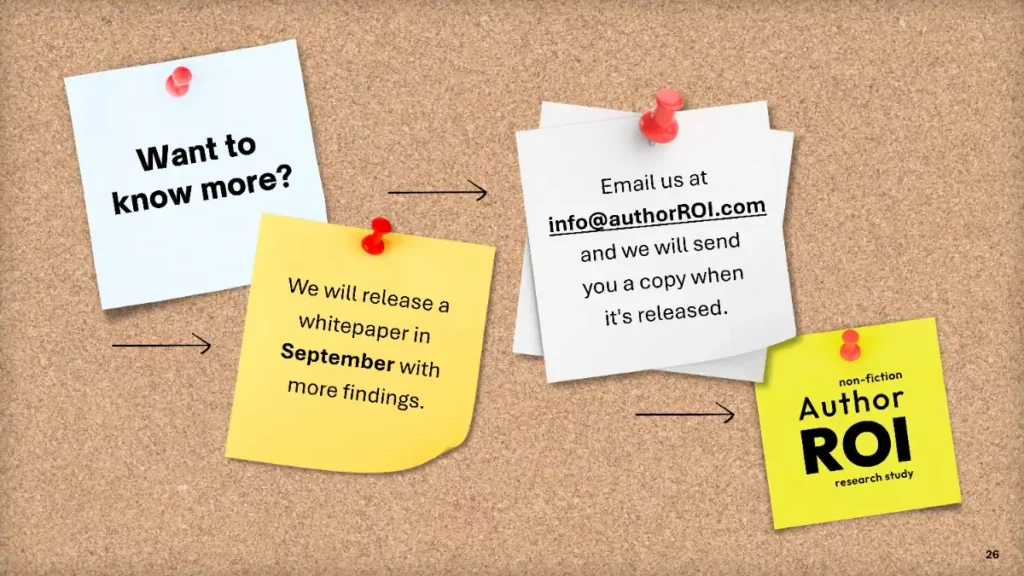
And so, you’ve heard me talk about a white paper. I want to ask all of you if you’re interested in knowing more about it, please send us an email to info at author roi.com, and we will send you a copy of the white paper. With all of the juicy sort of insights when it’s released. This was just a first peek into the data. There is a lot more for us to analyze as well as share. And I want to open this up to questions.
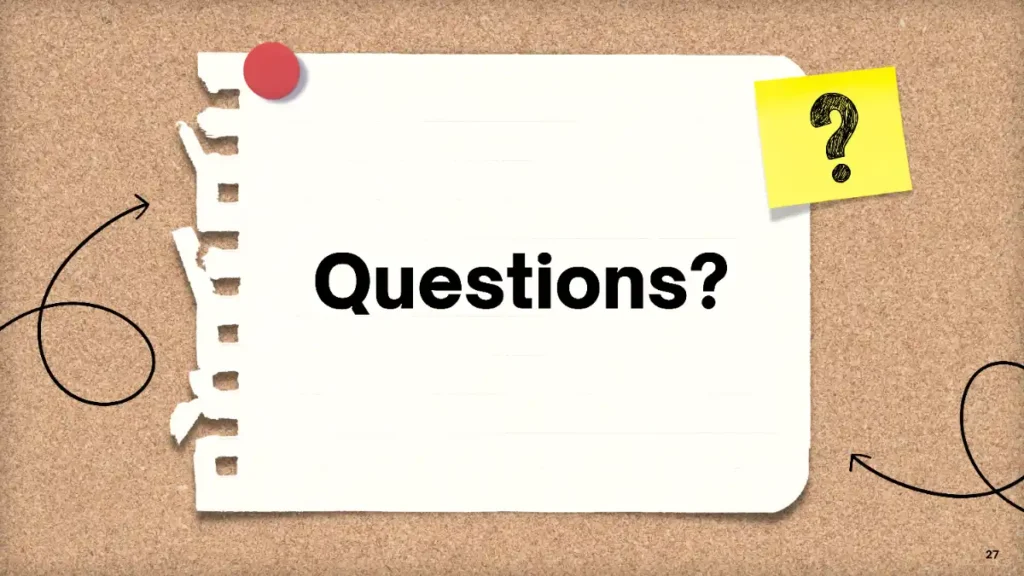
Okay. What did we learn from some of the verbatim comments? That’s a great question. So, there are two sources of verbatim comments. Okay. I’m going to turn over to speak to the survey verbatim to AJ. who looked through the massive data set. And then I’ll talk about some of the in-person interviews, AJ.
Dr. AJ Marsden We have a lot of qualitative data that we are sifting through, and we haven’t gone through all of it yet, but I have gone through some of it. Some of the things that we found was based on unexpected costs. So things that people thought would be a lot cheaper than they actually were, or things that they didn’t think that they would have to invest in at all. So we got some really good, rich information from those people. We also found and I haven’t quite gone through all of this yet, but we have found some interesting stuff with regards to how satisfied they are with their publisher. What things they feel like their publisher could have done better, some of the different services that they use. I’m digging into the soft ROI comments right now, specifically things that they thought went really well, some areas that they thought that they expected to do well, that didn’t do well. One of those areas is honestly social media. A lot of people expected their social media to take off, and it really didn’t. So those are some of the interesting comments that I’m seeing in the survey. Qualitative data.
Bill Sherman And then from the interview side. One of the things that I heard, and I’ll sum it up with a couple of top line comments. So I was speaking to someone who has only published one book, but he made a comment that stood out to me very clearly. He said in terms of my career and he’s published several years ago, he said, I can draw all line between everything that I’ve done before, my book and now everything after. He said that is the turning point of my career. Other pieces were, I think, a number of authors spoke about and we’ve heard this on our podcast as well. There is not only a question of imposter syndrome that holds people back from publishing. There’s also content insecurity and the question of: Are my ideas good enough for me to put them out in book form in the world? And then a little bit later, based in the interviews, they said there was a relief when I got that book out there, and I’ve heard people respond positively. Josh, I know you’ve been sifting through some of the data and the qualitative as well. Anything that you would like to add?
Josh Bernoff Well, I think one thing that specifically relates to author expectations is that the let me just put it this way, everyone’s disappointed with their publisher. Okay. The people with traditional publishers often have high expectations. Oh, I got a book contract with Wiley or whatever. And inevitably they find out that publishers don’t do nearly as much as they expected them to do. So that’s certainly something that, that any first-time author needs to understand. And I’ve found that even people who’ve published still think they’re publishers going to do more in the second and subsequent book and then get disappointed yet again.
Bill Sherman So the next question. Here is. What did good strategy mean to these authors? Again, AJ, I want to contextualize with how we shaped those questions. And then I’ll take it and probably hand off to Peter.
Dr. AJ Marsden Yes. So, we asked people not just did you have a strategy, yes or no. But instead, what was it about your strategy? So we asked, did you have a clear plan that outlined specific steps on what you were going to do? Did you have kind of a general, vague plan on what you were going to do, but you didn’t outline anything? You just kind of said, hey, I want to work towards this, and you just had a brief idea of how you were going to do it, or people that didn’t have any strategy at all. Did you kind of go into it with, you know, you’re just kind of flying by the seat of your pants type of thing. You didn’t have any strategy at all. You just said, I want to write a book, and you just dug right into it. So we kind of groups people into five different strategic categories. How you went about this process.
Bill Sherman And what I would add from that is, in addition to that question we asked in terms of how did you promote your book? A number of different modalities. Which ones did you use? Did you invest in them, and if so, what was the outcome and were how satisfied were you? Okay, so what we saw was a higher satisfaction between the people who had a strategy and knew what they were going to do, and then the outcomes they gave. This is a little bit higher. Parse and summarize, because there are a million ways to promote a book. I would ask that for more details, see forthcoming white paper on this. But it’s really about knowing where you’re going to execute and being purposeful. Okay. Peter. Anything to add on that?
Peter Winick Yeah, I think the strategy piece broke into two buckets. Number one is really on the up front, which a lot of publishers will help, which is who? Who are you writing this book for? The worst answer to that question is, oh, everybody could benefit from that book. That’s a really bad answer. The higher the level of specificity, the better. So I’ll use Josh’s book as an example. That’s not a book that’s for everybody. And that’s a good thing, right? So if you are not in the process or thinking about or someone that does write a better business book, probably not going to pick that one up, that’s a really good thing. The second part is, besides the who to me is the what’s next, right? So to me, a book is always the first step in the relationship, the first course in the meal. What do we want them to do next? And I think part of what the data showed us here is it’s not number of units sold times a buck or two or something per unit equals a big bucket of money. But what are the products, offerings and services you’re going to offer, which is based on who you’re serving and how they’re willing to pay for those services? Right. So it’s consulting, speaking, advisory, learning solutions, etc. You have to have both of those things worked out from a strategy standpoint before you write the book and certainly before you publish them.
Bill Sherman Thank you. So our next question is, are there specific book strategies or plans that seem to attract greater success? And the answer is yes, but it’s not a one size fits all. Certainly, one of the distinctions between publication modalities matters here. However, there were some that we called out earlier in the presentation that really bear worth underlining. One: ghost writing. You saw that ghost writing was represented across all three publication models, and it led to higher hard ROI. We also mentioned the in-store book campaigns. Now, is that a plan that fits everybody and their publication audience? Maybe. Maybe not. Right. And I would argue, you know, not everybody needs their book in the airport bookstore, but for a certain population trying to reach a certain audience, yes. That makes a lot of sense. Okay. Other things, the strategy and the work on strategy and then the efficacy of a PR campaign, knowing how to execute on that, where to invest time, energy and effort. And there’s a distinction which I will speak to an anecdata level. This comes from experiences calls qualitative interviews. There’s a distinction between getting on talk radio for most books or getting on even the Today Show or Good Morning America, versus reaching your target audience where they consume information, and you may get lower reach and higher return. And so I know I put several asterisks on this answer. We can go into it in more detail in the white paper. And the only other thing I can say is the data set is large. And the amount of data that we have is so rich, we haven’t had time because we closed the survey in early July to do all this analysis. Think of this as preliminary findings. Anyone want to add anything else in? Alison, Naren. Marissa.
Josh Bernoff I’m going to try and address this next question about the time frame.
Bill Sherman Hold on, I want to I want to give Alison and Neuron and Marissa a chance to jump in on things that predict success and attract success, and then move on to the next question.
Marissa Eigenbrood Yeah, I would add that quickly that I think when we talk about overall strategy, I’m seeing the benefits of, okay, from our perspective, the publicity and marketing strategy of it all, and in so many instances, be that conversation starts when the manuscript is sitting there, and that’s when we’re beginning to start that conversation around promoting the book. But when we look at this whole bigger brand platform and this, this, all of the other entities are so important here, kind of thinking about the strategy of all of these elements from day one, I think about the kind of the entire process all the way through and noting that the marketing and network engagement and how you’re gonna bring in your world that’s in the mix with that, as well as the fun PR of it all. And Bill, the riches, the niches is so important here, too, as you mentioned. But ensuring that when you’re thinking about strategy, it is from start to finish, even though the finish line might not necessarily have a clear end point and not necessarily waiting on the later steps in the until you have certain blocks completed in the process.
Alison Schwartz The only thing I would add is that since data so far is showing that working with a seasoned, proven ghostwriter has outside impact on returns for the book project, that it really pays to put the time in to picking your ghost, and to make sure you see a range of options from a reputable rider, and that you check references and things like that, and you make sure that you are working with someone who can go the distance with you. And a quite intense, intimate experience.
Naren Aryal Two items that I would tease. As authors, we have options to spend on a variety of marketing and placement opportunities. So, two things that I’m often asked about is the Hudson News Co-Op or airport placement. What I typically say is, I can almost guarantee you won’t make your money back on book sales at point of sale. And so, you know, that’s something that we’ll dive into is, as we continue down this path and, and issue the white paper, I’m sure. And then the other consideration that I’d like to bring up is best seller list. We’re often asked if there’s an ROI on hitting a bestseller list. And the answer from my experience is it depends. And there are a lot of options on Amazon, of course, to get that, yellow ribbon, does that really move the needle? I’ve got my theories on that. But there’s also an opportunity to spend a ton of money trying to chase some of these other lists. So, these are other considerations and discussions that, I hope we’ll be getting into.
Bill Sherman Fantastic. Josh, let me jump to you for a quick answer to the next question.
Josh Bernoff Okay. Yeah. So let me address this question about the time frame for when the authors see the ROI. You got to understand where the ROI is coming from, which is public speaking, consulting and leads. And these are not things that happen instantaneously. So I think for most authors, after you’ve launched the book, sometime in the next six months, you’ll begin to see a little bit of pick up. But you’re not really going to make back your money unless you look at it over, the year or two following the publication of the book.
Bill Sherman And I will add a realistic and heartbreaking example. So I know someone who published got a flurry of attention and they were wondering where were the leads? And the problem was the info email address for their book wasn’t forwarding and wasn’t being checked. And so you got to ask that question. And it’s heartbreaking. But all of the details matter to make this one. And so, I want to thank everyone for coming here to listen today to this preview of our findings on the author ROI study. I also want to remind you that if you want a copy of the white paper, and I hear we’ve had a number of people on this call already, email to us that if you send an email to info at author roi.com, you’ll be on the list to get a copy of the white paper. Also, if you were on the survey and you responded and you put your email address at the end of the survey of would you like to know the results? We’ll send you a copy as well. If you’re not sure, you put your email and you didn’t make it to the end, send us your email to info at author roi.com. First off, I want to thank everyone who joined as a attendee for this presentation and I want to give a huge shout out and thank you to the people who sponsored this. Again, Naren from Amplify Publishing Group, Gotham Ghostwriters, and Alison, who was here today with us. Marissa from Smith Publishing and all the work they do, Peter from Thought Leadership Leverage, and Josh Bernoff from his own consultancy and Build a Better Business Book for all of you. Thank you for joining. We look forward to sharing more information. And you will see also beyond the white paper on sharing more data. As we continue to dig into the question of how does a nonfiction author create ROI? Thank you everyone.
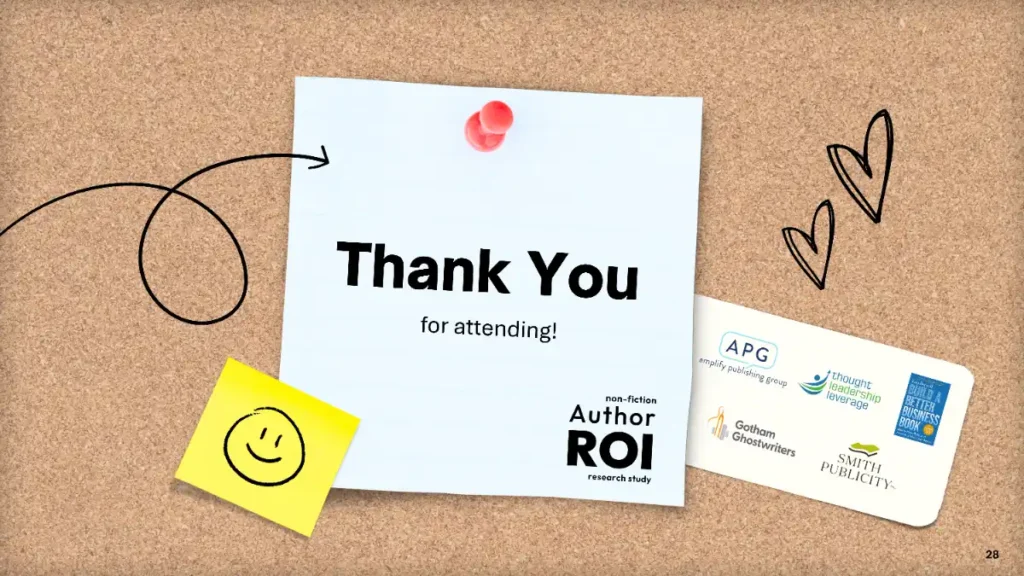
Peter Winick To learn more about Leadership Leverage, please visit our website at ThoughtLeadershipLeverage.com to reach me directly. Feel free to email me at Peter at ThoughtLeadershipLeverage.com, and please subscribe to Leveraging Thought Leadership on iTunes or your favorite podcast app to get your weekly episode automatically.


